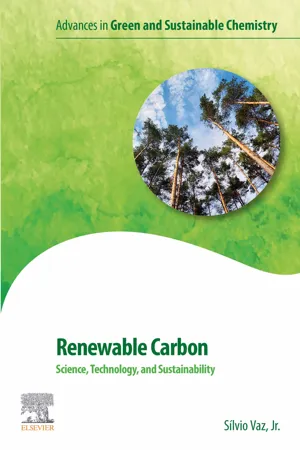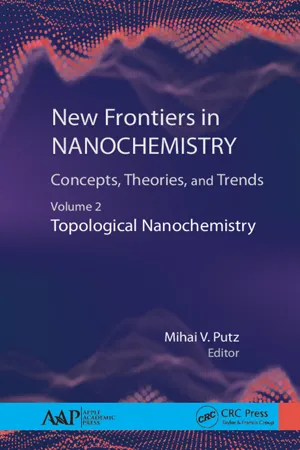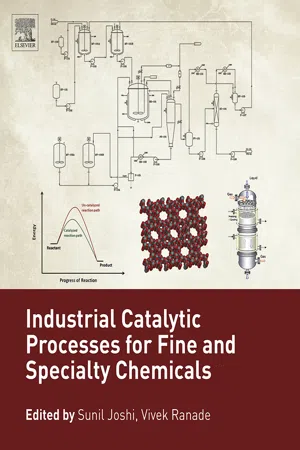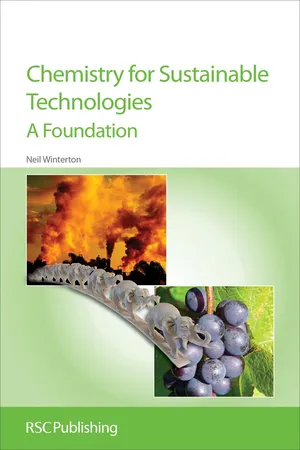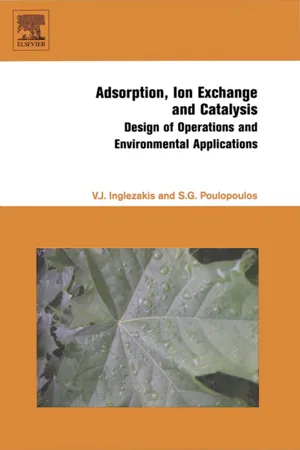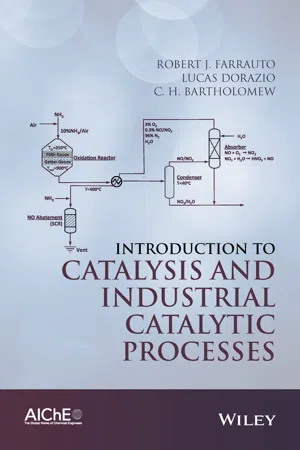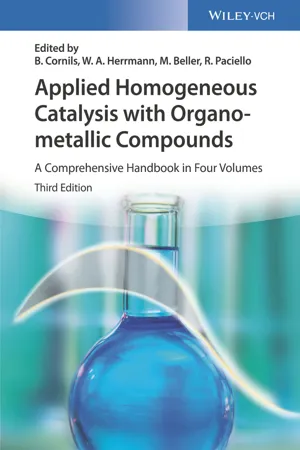Chemistry
Catalysis
Catalysis is the process of increasing the rate of a chemical reaction by the presence of a substance known as a catalyst. The catalyst itself remains unchanged at the end of the reaction and can be used repeatedly. This process is essential in many industrial and laboratory chemical reactions to improve efficiency and reduce energy consumption.
Written by Perlego with AI-assistance
Related key terms
Related key terms
1 of 4
Related key terms
1 of 3
10 Key excerpts on "Catalysis"
- eBook - ePub
Graphene Surfaces
Particles and Catalysts
- Karim Kakaei, Mehdi D. Esrafili, Ali Ehsani(Authors)
- 2018(Publication Date)
- Academic Press(Publisher)
[2] . He indicated that these findings could be rationally coordinated by the concept of Catalysis. Berzelius defined “Catalysis” as the decomposition of bodies by the catalytic force. This was the first recognition of Catalysis as a wide-ranging natural phenomenon!Another definition, which is still usable today, is attributable to Ostwald (1895) [3] : “a catalyst is a material that accelerates a chemical reaction without affecting the position of the equilibrium and thermodynamics of the reaction.” Ostwald proposed the concept of Catalysis as a universal dynamic phenomenon that was to be explained in terms of the laws of physical chemistry. His fundamental work was recognized with the Nobel Prize for chemistry in 1909.1.2. What Is Catalysis?
Catalysis is the entrance gate to chemical conversion. It is a phenomenon that accelerates chemical reactions by means of some small quantity of foreign material known as a catalyst [2 ,4 ]. According to Fig. 1.1 , a catalyst increases the rate of a chemical reaction by forming bonds with the adsorbents (A and B) and letting them react with each other to make products (P). Then, the products can desorb from the catalyst and it is recovered in its original form at the end of the reaction cycle.Catalysts do not have an unlimited life. During a chemical reaction, the production of side reactions or changes in the catalyst’s structure lead to the deactivation of the catalyst. Therefore, in practice, for the next reaction, the catalyst must be reactivated or replaced by a new catalyst. However, the rate of the reaction is affected by just the presence of a catalyst, neither by the thermodynamics of the reaction nor by the equilibrium composition.A catalyst offers a much more energetically favorable path for the reaction compared with not using the catalyst. It provides an alternative reaction pathway with much lower activation energy than the uncatalyzed reaction. The catalyzed reaction may involve several intermediate and transition-state complexes, which are completely different from the one-step mechanism for the reaction that occurs without any catalyst (Fig. 1.2 ). In other words, the catalyst equally accelerates both the forward and the backward reaction: if a catalyst increases the formation rate of the products from the reactants, it will also accelerate the decomposition of the products into the reactants passing through the transition states [4] - eBook - ePub
Renewable Carbon
Science, Technology and Sustainability
- Silvio Vaz Jr.(Author)
- 2022(Publication Date)
- Elsevier(Publisher)
2 into chemicals is, mostly, unfavorable from both the thermodynamic and kinetic point of view, which leads to the need for catalysts to perform the related reactions. To differ it from bioCatalysis using enzymes, it is defined as chemoCatalysis.According the International Union of Pure and Applied Chemistry (2021a) , a catalyst is a substance that increases the rate of a reaction without modifying the overall standard Gibbs energy change in the reaction, a process called Catalysis. The catalyst is both a reactant and product of the reaction. The words catalyst and Catalysis should not be used when the added substance reduces the rate of reaction. Catalysis can be classified as homogeneous and heterogeneous; in the first, only one phase is involved, and in the second, the reaction occurs at or near an interface between phases.Catalysis brought about by one of the products of a reaction is called autoCatalysis. Catalysis brought about by a group of reactant molecules is called intramolecular Catalysis. The term Catalysis is also often used when the substance is consumed in the reaction, for example, base-catalyzed hydrolysis of esters. Strictly, such a substance should be called an activator (International Union of Pure and Applied Chemistry, 2021a).Catalysts allow the reaction to proceed along a path at a lower activation energy (Fig. 11.1 ), which leads to an increase in reaction rate and a decrease in reaction time.Fig. 11.1 Comparison between activation energies for a reaction with the presence of catalyst (Eat1 ) and without the presence of catalyst (Eat2 ). (Credit: author.) - eBook - ePub
New Frontiers in Nanochemistry: Concepts, Theories, and Trends
Volume 2: Topological Nanochemistry
- Mihai V. Putz, Mihai V. Putz(Authors)
- 2020(Publication Date)
- Apple Academic Press(Publisher)
CHAPTER 4Catalysis
ADRIANA URDĂ and IOAN-CEZAR MARCU
Laboratory of Chemical Technology & Catalysis, Department of Organic Chemistry, Biochemistry & Catalysis, Faculty of Chemistry, University of Bucharest, 4-12, Blv. Regina Elisabeta, 030018 Bucharest, Romania, Tel: +40213051464, Fax: +40213159249,E-mail: [email protected] ; [email protected]4.1 DEFINITION
Catalysis represents the acceleration of thermodynamically possible chemical reactions by activating the reactants in the presence of compounds called catalysts. The acceleration comes from the lowered activation energy, which occurs when the reactant molecule interacts with the catalyst. Although the catalyst interacts with the reactant(s), it is not consumed in the reaction; therefore, it needs to be present only in very small amounts for the reaction to take place. Catalysis is one of the processes that support life through enzymatic reactions and, as a key concept in chemistry, it is involved in the synthesis of a large number of compounds used in everyday life.4.2 HISTORICAL ORIGIN(S)
Catalysis was already used in antiquity, even without knowing it: the alcoholic fermentation and the conversion of ethanol to acetic acid are chemical reactions catalyzed by enzymes (Bornscheuer & Buchholz, 2005; Hagen, 2006). In medieval times, the use of the philosopher’s stone to transform base metals into “gold” was a catalytic concept (Lohse, 1945).In 1834, Mitscherlich introduced the term “contact” in his report discussing the conversion of alcohol into ether and water in the presence of dilute sulfuric acid (Davis, 2008). The concept of “Catalysis” was coined by the Swedish chemist Berzelius in 1835 (Lohse, 1945; Somorjai, 1994), and in 1894, Ostwald defined it as “the acceleration of a slow chemical process by the presence of a foreign material” (Ertl, 2009), while the first definition of “catalyst” was given by Armstrong in 1885 (Davis, 2008). Later, in 1901, he defined a catalyst as “a material that changes the rate of a chemical reaction without appearing in the final product” (Ertl, 2009). Sabatier proposed in 1923 the temporary formation of unstable chemical compounds between catalysts and reactants, believing them to be intermediate steps in the reaction (Védrine, 2014). Kinetic studies in adsorption/desorption phenomena, crucial in heterogeneous catalyzed processes, were initiated by Langmuir and developed by Hinshelwood (Davis, 2008). - eBook - ePub
Chemistry for Sustainable Technologies
A Foundation
- Neil Winterton(Author)
- 2021(Publication Date)
- Royal Society of Chemistry(Publisher)
2 Evidence for this should already be apparent from the various contributions of Catalysis to waste minimisation in chemicals processing mentioned earlier. The purpose of this chapter, having first introduced the concept, is to explore and exemplify the central importance of Catalysis to the efficiency of industrial chemicals production—past, present and future. Also of industrial importance is the related concept of catalyst inhibition, a phenomenon that results from the direct effect on a catalyst of suppressing its activity rather than by any change to the reaction activation energy. The key empirical measures of catalyst performance are considered in Section 10.2.A catalyst is a chemical component of a reacting system that changes the rate of reaction without itself being consumed in the reaction being catalysed. The catalytic species may not be the material initially added, but may be derived from it. In such circumstances, the material added will be known as the pre-catalyst. Much of catalyst research is centred on identifying the precise nature of the active catalytic species, even its physical form. Investigating working catalysts under industrially-relevant conditions (‘operando’ studies2 ) is a major experimental and technical challenge. Advances in experimental and analytical techniques have also facilitated the study of Catalysis by isolated metal atoms (‘single atom Catalysis’Types of catalyst and Catalysis are many and varied, including:3a ,b).- heterogeneous Catalysis (Section 10.1.1);
- homogeneous Catalysis (Section 10.1.2);
- enzyme and bio-Catalysis (Section 10.1.3);
- organoCatalysis (Section 10.1.4);
- asymmetric Catalysis (Section 10.1.5);
- environmental Catalysis (Section 10.8);
- biphasic and phase transfer Catalysis;
- combinatorial Catalysis (Section 10.1.6);
- electroCatalysis and photoCatalysis (discussed briefly in Sections 9.10.3 and 9.10.1).
Each has been an important independent area of study and application. Several have been met incidentally in earlier chapters. Most will be introduced or further illustrated during the course of this and the remaining chapters on the use of renewable feedstocks for chemicals manufacture and energy generation. Increasingly, studies focus on the overlap between hitherto-independent areas of Catalysis and on aspects of material science and nanoscience, seeking new insights that might arise from unifying them at the molecular level.4 Detailed consideration of ‘hybrid Catalysis ’ and ‘tandem Catalysis - eBook - ePub
- Anju Srivastava, Rakesh K. Sharma, Anju Srivastava, Rakesh K. Sharma(Authors)
- 2021(Publication Date)
- Jenny Stanford Publishing(Publisher)
William H. Stein 1909 Catalysis and investigations on the fundamental principles governing chemical equilibria and rates of reaction Wilhelm Ostwald3.2 Role of CatalysisCatalysis plays a crucial role in producing environmentally benign chemicals, both new and existing, while saving energy, time, raw materials, and cost related to the overall process [4 , 5 ]. The role of a catalyst has been summarized below.- Catalysis decreases the activation energy required for a chemical reaction and thus enhances the rate of reaction.
- It allows reactions to proceed under milder reaction conditions; therefore, catalytic reactions are considered efficient.
- The greater activity of catalysts can sometimes lead to the conversion of million times their own weight.
- Catalysts allow high product selectivity in multifunctional compounds by enabling site-specific transformations and diastereomeric control. This allows the effective utilization of resources and minimization of waste.
- Catalytic methods also circumvent the need for activation and deactivation of starting materials in the prefunctionalization steps, thereby lessening the number of steps in a reaction.
- Catalysis prevents pollution by avoiding the formation of unwanted side-products in a reaction.
- Catalysts are also applied for improving air quality by removing and controlling NOX emissions, decreasing the use of volatile organic solvents, and replacing chlorine-based chemicals by developing alternate catalytic methodology.
- Catalysis is employed for the production of transportation fuels and bulk and fine chemicals all over the world.
- Catalysts that can be reused provide economic feasibility and facilitate their industrial application.
Parameters affecting both commercial usefulness and greenness of a particular catalyst are depicted in Fig. 3.4. - Sunil S Joshi, Vivek V. Ranade(Authors)
- 2016(Publication Date)
- Elsevier(Publisher)
With strict environmental regulations, rising raw material prices, depleting feedstocks, and a call for green chemistry as driving forces, the chemical industry faces a larger challenge with both opportunities and risks. Catalysis is of paramount importance in the chemical industry due to its direct involvement in the production of 80% of industrially important chemicals. Catalysts are involved in more than $10 trillion in goods and services of the global gross domestic product (GDP) annually. It is estimated that the global demand on catalysts is more than $30 billion, and a very robust growth is projected in the future. There is an urgent need to develop cost-effective and environmentally benign methods of converting natural resources into fine and specialty chemicals using highly efficient catalysts and employing cleaner methodologies. The advancements in Catalysis and applications to the chemical industry are very significant and are responsible for cleaner processes. Replacement of the stoichiometric reactions by catalytic reactions and application of new catalyst systems and technologies to make the processes environmentally friendly, energy efficient, and globally competitive are current needs.A catalyst is a substance that provides an alternative route of reaction where the activation energy is lowered. Catalysts don’t affect the chemical equilibrium associated with a reaction; they merely change the rates of reactions. Catalysts are classified in a variety of different ways. The commonly used classification by reaction engineers is based on number of phases, such as• homogenous Catalysis (catalyst and substrate in same phase) or• heterogeneous Catalysis (solid catalyst and substrate is a gas and/or liquid)Basic concepts of Catalysis are briefly introduced in the following section.It is important to combine the understanding of Catalysis with key reaction engineering expertise to translate the potential of a catalyst in the form of a practically implemented catalytic process or plant. Any catalytic reactor has to carry out several functions like bringing reactants into intimate contact with the active sites on a catalyst (to allow chemical reactions to occur), providing an appropriate environment (temperature and concentration fields) for adequate time, and allowing for removal of products. A reactor engineer has to ensure that the evolved reactor hardware and operating protocol satisfy various process demands without compromising safety, the environment, and economics. Naturally, successful reactor engineering requires bringing together better chemistry [thermodynamics, Catalysis (replace reagent-based processes), improved solvents (supercritical media, ionic liquids), improved atom efficiency, waste prevention — leave no waste to treat] and better engineering (fluid dynamics, mixing and heat and mass transfer, new ways of process intensification, computational models, and real-time process monitoring and control). Some of these aspects are briefly discussed in Section 1.3- eBook - ePub
Chemistry for Sustainable Technologies
A Foundation
- Neil Winterton(Author)
- 2015(Publication Date)
- Royal Society of Chemistry(Publisher)
CHAPTER 10Catalysis
‘Jöns Jacob Berzelius, 1836This new force, which was unknown until now, is common to organic and inorganic nature. I do not believe that this is a force entirely independent of the electrochemical affinities of matter; I believe, on the contrary, that it is only a new manifestation, but since we cannot see their connection and mutual dependence, it will be easier to designate it by a separate name. I will call this force catalytic force. Similarly, I will call the decomposition of bodies by this force Catalysis, as one designates the decomposition of bodies by chemical affinity analysis.’Of all the sub-disciplines of chemistry, Catalysis is the one whose fundamental study is most intimately linked with its technological application.i Evidence for this should already be apparent from the various contributions of Catalysis to waste minimisation in chemicals processing already mentioned. The purpose of this chapter, having first introduced the concept, is to explore further and exemplify the central importance of Catalysis to the efficiency of large-scale chemicals production—past, present and future.A catalyst is a chemical component of a reacting system that changes the rate at which chemical equilibrium is attained without itself being consumed in the reaction being catalysed. Types of catalyst and Catalysis are many and varied, including:- homogeneous Catalysis
- heterogeneous Catalysis
- asymmetric Catalysis
- supported Catalysis
- bioCatalysis
- phase transfer Catalysis
- organoCatalysis
- electroCatalysis
- photoCatalysis (Section 9.10.1)
- hybrid Catalysis
- combinatorial Catalysis
- environmental Catalysis.
Each is an important independent area of study and application. Several of these areas have been met, incidentally, so far. Most will be introduced or further illustrated during the course of this and the remaining chapters on the use of renewable feedstocks for chemicals manufacture and energy generation. - eBook - ePub
Adsorption, Ion Exchange and Catalysis
Design of Operations and Environmental Applications
- Stavros G. Poulopoulos, Vassilis J. Inglezakis(Authors)
- 2006(Publication Date)
- Elsevier Science(Publisher)
5 Catalysis Publisher Summary This chapter explains the process of Catalysis, focusing on heterogeneous Catalysis to control pollution. A heterogeneous catalyst accelerates a reaction that has fluid phase reactants and products, while itself remaining unchanged by the reaction. In general, it does this by stabilizing reactive intermediates whose formation would be energetically unfavorable in the fluid phase. The overall process of a catalytic reaction taking place in a porous catalyst particle involves—transport of reactants from the bulk of the fluid to the exterior surface of the catalyst (external mass transfer resistance), transport of reactants from the surface to the interior of the catalyst through pores (internal mass transfer resistance), adsorption of reactants onto the active sites on the internal surface of the catalyst, reaction of adsorbed reactants to form adsorbed products, desorption of products, transport of products out of the pores to the particle external surface, and transport of products from the external surface of the catalyst to the main body of the fluid. In the context of sustainable development, all spent catalysts should be recycled as far as possible, or properly disposed off in an environmentally friendly manner, in case recycling is not possible. 5.1 TYPES OF CATALYSTS In Chapter 2, some basic definitions about Catalysis were given. In this section, subjects in relation to Catalysis are discussed in depth. First of all, let us examine the various types of catalysts and properties before moving on to Catalysis issues. Catalysts can be sorted in various ways depending on the criterion of classification. So, they can be classified into homogeneous or heterogeneous catalysts, depending on whether they are in the same phase as reactants and products or not. Furthermore, based on its physical state, a catalyst can be gas, liquid, or solid - Robert J. Farrauto, Lucas Dorazio, C. H. Bartholomew(Authors)
- 2020(Publication Date)
- Wiley-AIChE(Publisher)
1CATALYST FUNDAMENTALS OF INDUSTRIAL Catalysis1.1 INTRODUCTION
Chemical reactions occur by breaking the bonds of reactants and forming new bonds and new compounds. Breaking stable bonds requires the absorption of energy, while making new bonds results in the liberation of energy. The combination of these energies results in either an exothermic reaction in which the conversion of reactants to products liberates energy or an endothermic process in which the conversion process requires energy. In the former case, the energy of the product is lower than that of the reactants with the difference being the heat liberated. In the latter case, the product energy is greater by the amount that must be added to conserve the total energy of the system. Under the same reaction conditions, the heat of reaction (ΔH) being a thermodynamic function does not depend on the path or rate by which reactants are converted to products. Similarly, ΔG of the reaction is not dependent on the reaction path since it too is a thermodynamic state function. This will be emphasized once we discuss catalytic reactions. The rate of reaction is determined by the slowest step in a conversion process independent of the energy content of the reactants or products.1.2 CATALYZED VERSUS NONCATALYZED REACTIONS
In the most basic sense, the purpose of the catalyst is to provide a reaction pathway or mechanism that has a lower activation barrier compared to the noncatalyzed (Enc ) pathway, as illustrated in Figure 1.1 . Also shown is the catalyzed barrier (EMn ). In any reaction, catalyzed or noncatalyzed, the reaction sequence occurs through a series of elementary steps. In a noncatalyzed reaction, the species that participate in the reaction sequence are derived solely from the reactants. In a catalyzed reaction, the catalyst is simply an additional species that participates in the reaction sequence by lowering the activation energy and hence enhances the kinetics of the reaction. Finally, during the catalyzed reaction sequence, the catalyst species returns to its original state. It is the regeneration of the catalyst species to its original state that makes a catalyst a “catalyst” and not a “reactant.” Thus, a catalyst is a species that participates in the reaction sequence—it interacts with the “reactants” to form an intermediate species that undergoes further reaction to form the “product” with the catalyst returning to its original state. This basic sequence of events is illustrated in Figure 1.2- eBook - ePub
Applied Homogeneous Catalysis with Organometallic Compounds
A Comprehensive Handbook in Four Volumes
- Boy Cornils, Wolfgang A. Herrmann, Matthias Beller, Rocco Paciello, Boy Cornils, Wolfgang A. Herrmann, Matthias Beller, Rocco Paciello(Authors)
- 2017(Publication Date)
- Wiley-VCH(Publisher)
13 Chemical Reaction Engineering Aspects of Homogeneously Catalyzed Processes Manfred Baerns1 and Peter Claus2 1 Fritz-Haber Institut der MPG, Dept. Inorganic Chemistry, Faraday-Weg 4-6, 14195 Berlin, Germany 2 TU Darmstadt, Ernst-Berl Institut, Petersenstr.20, 64287 Darmstadt, Germany13.1 Introduction
Liquid-phase homogeneous catalytic reactions that are carried out in the absence of a second or even third phase, that is, a gas or an immiscible liquid, can be treated from a chemical reaction engineering point of view in analogy to other homogenous reactions. If the chemical kinetics of such homogeneous catalytic reactions are known, the reactor performance can be usually predicted with respect to conversion and selectivity. When transport processes between a liquid and a gas phase play a significant role, the transport processes also have to be considered (see below) in a similar way as catalytic gas-phase reactions on solid catalysts with diffusional transport limitations; the required procedures have been extensively described in various textbooks, for example, References [1–3].In a wider sense, such reactions that are catalyzed by enzymes or nano-scale catalytic solid materials dissolved in a liquid phase may also be ascribed to homogeneously catalyzed reactions, which are, however, not included here although the gap between enzyme Catalysis and homogeneous Catalysis will most probably narrow in the near future. This is illustrated by the fact that enzymes are being adopted as industrial bioCatalysis by means of evolutionary procedures under non-natural conditions or homogeneous catalysts show up that mimic principles of enzyme Catalysis [4].In two-phase systems in which the catalytic reaction takes place in the liquid phase between a liquid reactant and gaseous reactants, the latter have to be transferred over the gas/liquid boundary layer into the liquid phase. In this situation the reaction engineering prediction described above can be performed in an analogous way as long as the rate of transfer of the gaseous reactants into the liquid phase is fast compared with the intrinsic catalytic reaction, that is, as long as the transport processes are much faster than the intrinsic catalytic reaction itself. Under these circumstances it can usually be assumed that the liquid-phase concentrations of the gaseous reactants correspond to gas/liquid thermodynamic equilibrium.
Index pages curate the most relevant extracts from our library of academic textbooks. They’ve been created using an in-house natural language model (NLM), each adding context and meaning to key research topics.
Explore more topic indexes
Explore more topic indexes
1 of 6
Explore more topic indexes
1 of 4

